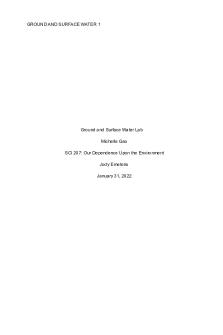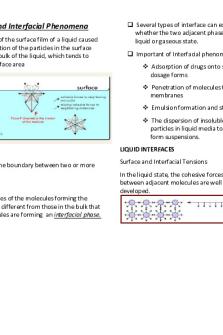Ground and Surface Water Lab PDF

| Title | Ground and Surface Water Lab |
|---|---|
| Course | Our Dependence Upon the Environment |
| Institution | The University of Arizona Global Campus |
| Pages | 8 |
| File Size | 140.6 KB |
| File Type | |
| Total Downloads | 24 |
| Total Views | 164 |
Summary
Lab...
Description
GROUND AND SURFACE WATER 1
Ground and Surface Water Lab Michelle Gao SCI 207: Our Dependence Upon the Environment Jody Emeterio January 31, 2022
GROUND AND SURFACE WATER 2
Ground and Surface Water Interactions Lab It is imperative to know how human activities and behavior impact the environment around them. Clean water is vital to all life, and the resources are running low to provide the necessary need. The overconsumption, pollution, and human influences are creating an environment that fresh, clean water is at an all-time low and no natural way to replenish one of the essential resources for life on earth. Authors Yoshihide Wada, Inge E. M. De Graaf, and Ludovicus P. H. Van Beek state to evaluate the effects of human impacts on surface water and groundwater resources has created such a demand that exceeds the availability of water worldwide (2016). For the first activity, the hypothesis is that removing the water from the well will cause the water level to decrease. The well, when drained, will fill with water from the source until almost equal to the level of the source. The activity two hypotheses are that the dam in its place will prevent the wastewater from contaminating the groundwater. The third hypothesis for the last activity is the fertilizer will impact the lower areas compared to the higher elevation. As the water runoff goes down, it will collect the fertilizer. Once in the final location, the water will have a high concentrate of fertilizer mixed with the water. Materials and Methods To test the hypothesis of each activity will involve the creation of the environment for each activity. The environment will need to be built in a container and a block of clay. Place the clay block to where one-third of the container is separated from the other two thirds. Making sure the clay is sealed to not allow leaks for the testing process. In the container, add a layer of sand and level out. Take each half of the clear tube and place one on each side of the smaller side. The plastic tubes will represent wells. Add another level of sand where one level of sand is higher on one well than the other. Take some gravel and create a layer on top of the sand, creating an incline towards the dam and the opposing well. Take the foam cup and poke roughly ten holes in the bottom. Take
GROUND AND SURFACE WATER 3 another cup and fill it with tap water. Take the foam cup and hold over the top of the slope that was just created. Fill the area until the water level is just above the clay (dam). Insert a straw into one of the wells and place the index finger over the opposite end of the straw. This will seal the straw and prevent water from escaping. Remove the straw and mark with a permanent marker the waterline. Next, take a disposable pipet and release the air in the bulb by squeezing it closed. Insert into the well and drain the water. Now take the straw and place into the well. Seal again with finger and remove. Mark level again on the straw and wait two minutes while observing the well that was just drained. Reinsert straw again, seal, and mark the level. Activity two requires the use of the same model. Activity two needs a thin, flexible aquarium tube that taped to the larger side of the container and not touching the bottom. The reservoir needs to be filled with water just above the clay. Take a cup full of water mixed with a portion of the kool-aid packet; this represents the waste. Take the 10-mL syringe and fill with the wastewater and inject it into the aquarium tube on the container. Observe what happens as the wastewater is introduced to the reservoir. After completing take handfuls of the gravel and sand mixture and rinse trying to keep as much sand as possible. Activity three requires the building of a new environment which has the bar of clay flatten as much as possible into a six-by-six-centimeter square. Take the aquarium tube and tape one half to one end of the container. Do the same to the other end with the other half of the tubing. Again, making sure that the pipe does not touch the bottom of the container. Choose one side of the container and fill with just slightly higher than the bottom of the plastic tube. Now on the other side, create a slope of sand a few centimeters higher than the opposing side. Create a layer of gravel on top continuing with the sloping approach. Take the flatten clay, place on top of the hillside, and seal around the tubing to prevent any leaks. Top the clay with sand with the sloping approach like the rest of the environment. At the bottom of the hill, dig out a small circular hole and fill with water to represent a pond. Take the kool-aid packet and
GROUND AND SURFACE WATER 4 sprinkle the remaining powder down the surface of the landscape. Take the foam cup with holes and a cup of water and hold over the top of the model at the highest point. Fill the foam cup with the water and observe what happens to the ground and pond water. Wait thirty seconds and using the 10- mL syringe and insert it into the tubing to pump water out of the opposing side of the clay. Observe the water in the syringe. Use the syringe an again pull water out of the container from the opposite side and observe the water. Observations: Activity 1. 2.3 cm—water level 0.4 cm—water level after excessive usage 1.2 cm—water level after 2 mins The well-filled slowly back into the well. The level of water in the well decreases from the first measurement. Activity 2. As the wastewater discharged into the clean water, it was centralized around the pipe as more waste was introduced to the wastewater spread throughout the reservoir. Activity 3. The rainwater spread the fertilizer into the soil but as the water ran downhill most of the fertilizer followed After 30 seconds the water has a pinkish-red tint
GROUND AND SURFACE WATER 5 The side that has the impermeable layer had a very slight pinkish tint
GROUND AND SURFACE WATER 6 Running head: GROUND AND SURFACE WATER 5 Photographs: Figure 1 The model of the environment and the different water levels markings. Figure 2 The environment for activity two. Figure 3 The color of the water after a water runoff for activity three opposite side from the clay. Discussion Activity one was a test on water levels after a high demand impacted the source. The hypothesis for the activity is that the removal of the water from the well will decrease the reservoir water level. The test was able to show how excessive usage of water is affecting the water crisis. The lab was able to prove the hypothesis that the groundwater would not be affected by the wastewater because of the dam to be correct. The wastewater was not able to reach the groundwater because the barrier prevented the wastewater from spreading to the groundwater. In activity three, the test was to see how fertilizer and water runoff impact water sources. The lab hypothesized that the lower water source would contain more fertilizer than the upper source. The lab was able to prove the hypothesis to be correct.
The activities provided a better explanation of how ground and surface water can become contaminated and how excessive use is depriving the earth of the water sources. Did find that groundwater at higher elevations has a significant chance of still being utilized due to the lower levels of contaminants compared to lower elevation groundwater. Also, that natural substances such as iron and fluorides can cause contamination. The Environmental Protection Agencyexplains that substances found
GROUND AND SURFACE WATER 7 naturally in rocks and soil can dissolve into the groundwater (2015). Even other elements, such as decaying organic material, can move to the groundwater and produce undesirable odor, taste, or color. Unacceptable groundwater is not meant for consumption; it must be treated to remove contaminants beforehand. The challenges that were encountered were more towards the guide that was provided by Carolina Distance Learning (n.d.). The steps to complete each activity could have more steps or pictures to show exactly what is being asked. There were times where the outcome of what was being developed was unsure. There was a feeling of uncertainty a few different times throughout each activity. That sense of skepticism can make the lab feel that outcome is not what is being sought. For future research, updating the guide to have more pictures and clear step by step instructions would be beneficial. The updated information would ease the sense of uncertainty and doubt the scientist may have. Also, providing a bigger diagram to perform each test to get a clearer picture or the result of what is being tested. Having a broader environment will allow a more effective outcome of the results. Plus, the container provided was not sturdy and almost broke when building each environment. A more durable container would also alleviate the worry of possibly breaking the main component of the environment.
GROUND AND SURFACE WATER 8 References Carolina Distance Learning. (n.d.). Ground and surface water interactions [Investigation manual]. Retrieved from https://ashford.instructure.com Environmental Protection Agency. (2015). Getting Up to Speed: Ground Water Contamination. Environmental Protection Agency. Retrieved from https://www.epa.gov/sites/production/files/2015-08/documents/mgwc-gwc1.pdf Wada, Y., De Graaf, I. E. M., & Van Beek, L. P. H. (2016). High-resolution Modeling of Human and Climate Impacts on Global Water Resources. Journal of Advances in Modeling Earth Systems. Volume 8, Issue 2: PG. 735-763. Retrieved from https://doi-org.proxylibrary.ashford.edu/ 10.1002/2015MS000618...
Similar Free PDFs

Ground and Surface Water Lab
- 8 Pages

Week 3 lab ground water and surface
- 10 Pages

Surface Topography Lab
- 11 Pages

Properties of Water Lab
- 8 Pages

Water Balance Lab report
- 14 Pages

corrosion and surface chemistry
- 615 Pages

Surface and Interfacial Phenomena
- 16 Pages

Water Quality Lab Report
- 7 Pages

Water Pollution lab report
- 10 Pages

Water Hardness Lab Report
- 5 Pages

Water Potential Lab
- 4 Pages
Popular Institutions
- Tinajero National High School - Annex
- Politeknik Caltex Riau
- Yokohama City University
- SGT University
- University of Al-Qadisiyah
- Divine Word College of Vigan
- Techniek College Rotterdam
- Universidade de Santiago
- Universiti Teknologi MARA Cawangan Johor Kampus Pasir Gudang
- Poltekkes Kemenkes Yogyakarta
- Baguio City National High School
- Colegio san marcos
- preparatoria uno
- Centro de Bachillerato Tecnológico Industrial y de Servicios No. 107
- Dalian Maritime University
- Quang Trung Secondary School
- Colegio Tecnológico en Informática
- Corporación Regional de Educación Superior
- Grupo CEDVA
- Dar Al Uloom University
- Centro de Estudios Preuniversitarios de la Universidad Nacional de Ingeniería
- 上智大学
- Aakash International School, Nuna Majara
- San Felipe Neri Catholic School
- Kang Chiao International School - New Taipei City
- Misamis Occidental National High School
- Institución Educativa Escuela Normal Juan Ladrilleros
- Kolehiyo ng Pantukan
- Batanes State College
- Instituto Continental
- Sekolah Menengah Kejuruan Kesehatan Kaltara (Tarakan)
- Colegio de La Inmaculada Concepcion - Cebu




